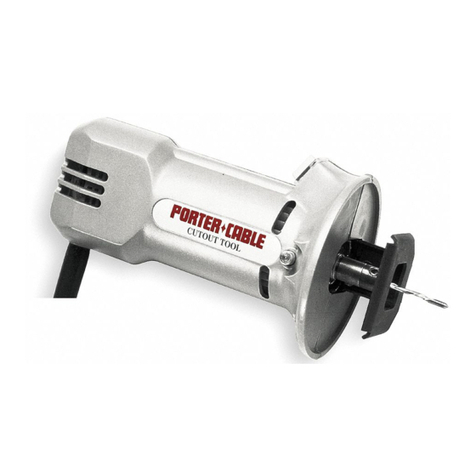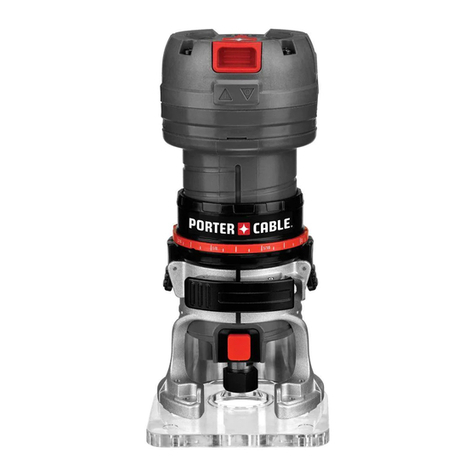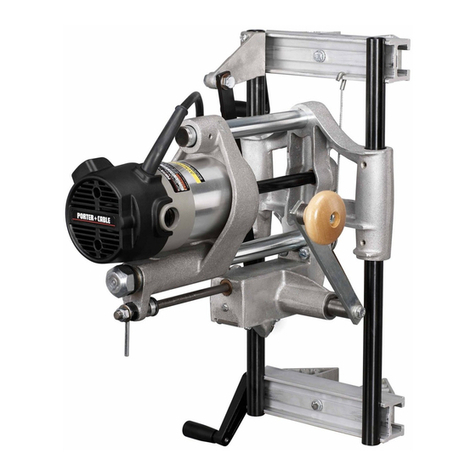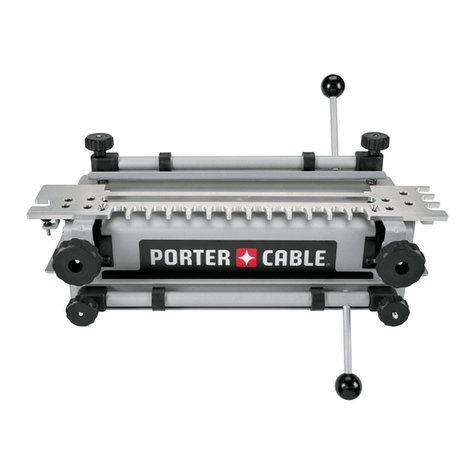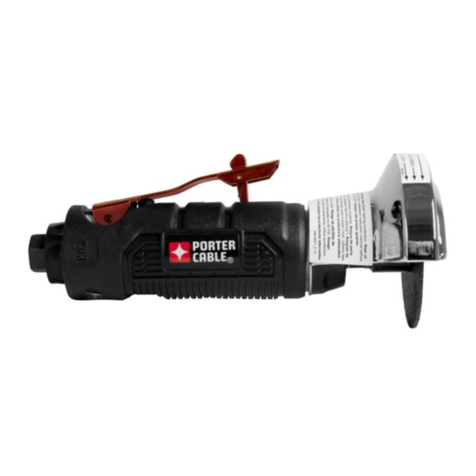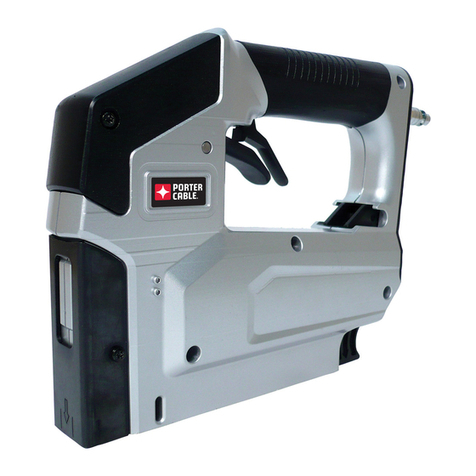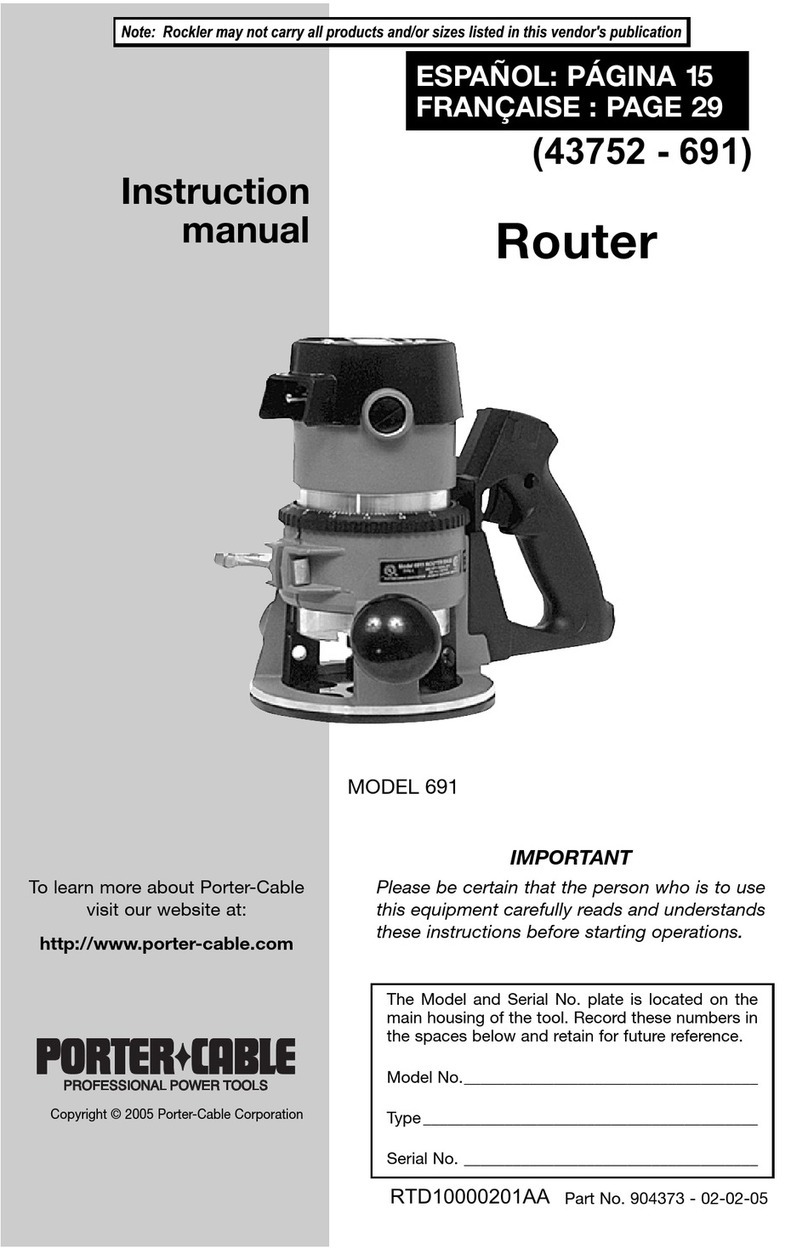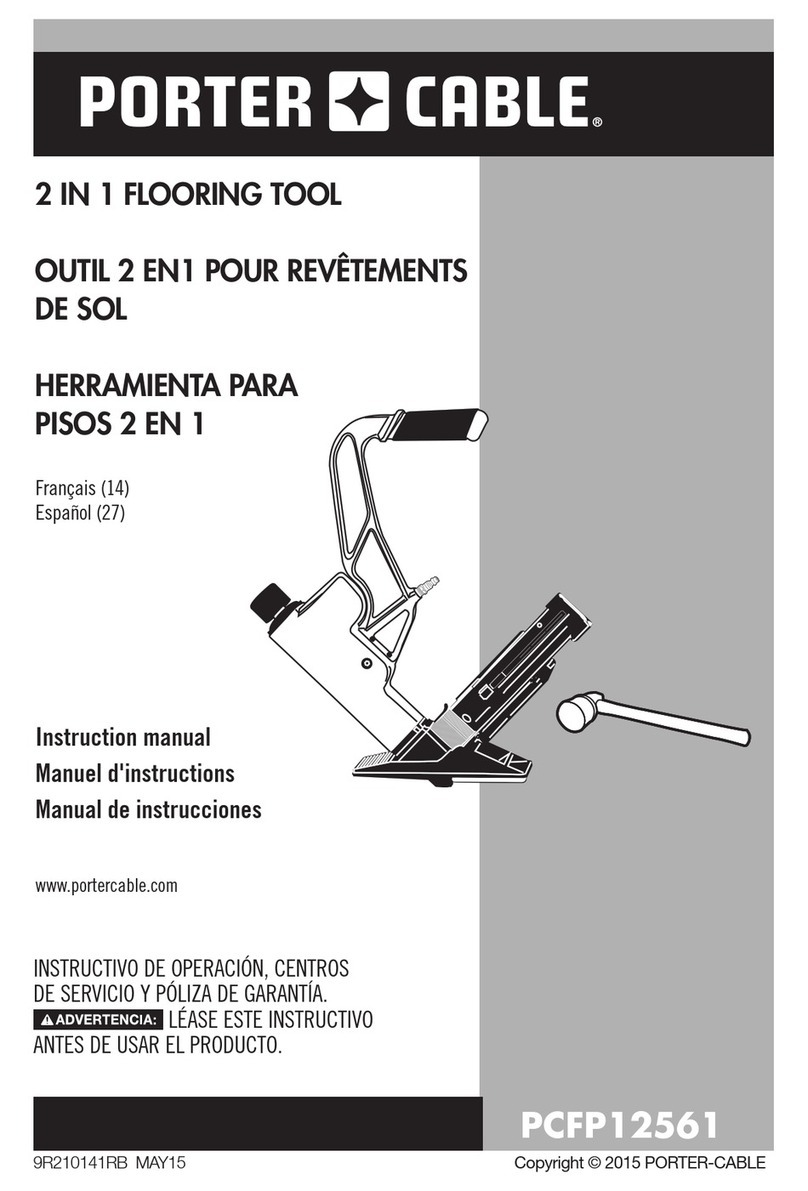
Page iv PORTER-CABLE OMNIJIG®
Read and understand all instructions. Failure to follow all instructions listed below, may result
in electric shock, fire and/or serious personal injury.
There are certain applications for which this tool was designed. Do not modiy and/or use for
any applications other than for which it was designed. If you have any questions relative to its application DO
NOT use the tool until you have written PORTER-CABLE and we have advised you. You can write to Technical
Service Manager; PORTER-CABLE; 4825 Highway 45 North; Jackson, TN 38305.
SAVE THESE INSTRUCTIONS
GENERAL SAFETY RULES
1. KEEP WORK AREA CLEAN. Cluttered areas and benches invite injuries.
2. AVOID DANGEROUS ENVIRONMENT. Don’t expose power tools to rain. Don’t use power tools in damp or
wet locations. Keep area well lit. Avoid chemical or corrosive environment. Do not use tool in presence of
flammable liquids or gases.
3. GUARD AGAINST ELECTRIC SHOCK. Prevent body contact with grounded surfaces. For example: pipes,
radiators, ranges, refrigerator enclosures.
4. KEEP CHILDREN AWAY. Do not let visitors contact tool or extension cord. All visitors should be kept away from
work area.
5. STORE IDLE TOOLS. When not in use, tools should be stored in dry, and high or locked-up place – out of reach
of children.
6. DON’T FORCE TOOL. It will do the job better and safer at the rate for which it was intended.
7. USE RIGHT TOOL. Don’t force small tool or attachment to do the job of a heavy duty tool. Don’t use tool for
purpose not intended – for example – do not use a circular saw for cutting tree limbs or logs.
8. DRESS PROPERLY. Do not wear loose clothing or jewelry. Loose clothing, draw strings and jewelry can be
caught in moving parts. Rubber gloves and non-skid footwear are recommended when working outdoors.
Wear protective hair covering to contain long hair.
9. USE ANSI Z87.1 SAFETY GLASSES. Wear safety glasses or goggles while operating power tools. Also face
or dust mask if operation creates dust. All persons in the area where power tools are being operated should
also wear safety glasses and face or dust mask.
10. WEAR ANSI S3.19 EAR PROTECTION to safeguard against possible hearing loss.
11. DON’T ABUSE CORD. Never carry tool by cord or yank it to disconnect from receptacle. Keep cord from heat,
oil, and sharp edges. Have damaged or worn power cord and strain reliever replaced immediately. DO NOT
ATTEMPT TO REPAIR POWER CORD.
12. SECURE WORK. Use clamps or a vise to hold work. It’s safer than using your hand and it frees both hands to
operate tool.
13. DON’T OVERREACH. Keep proper footing and balance at all times.
14. MAINTAIN TOOLS WITH CARE. Keep tools sharp and clean for better and safer performance. Follow
instructions for lubricating and changing accessories. Inspect tool cords periodically and if damaged, have
repaired by authorized service facility. Inspect extension cords periodically and replace if damaged. Have all
worn, broken or lost parts replaced immediately. Keep handles dry, clean and free from oil and grease.
15. DISCONNECT TOOLS when not in use, before servicing, and when changing accessories such as blades, bits, cutters,
etc.
16. REMOVE ADJUSTING KEYS AND WRENCHES. Form habit of checking to see that keys and adjusting
wrenches are removed from the tool before turning it on.
17. AVOID UNINTENTIONAL STARTING. Do not carry a plugged-in tool with finger on switch. Be sure switch is
off when plugging in. Keep hands, body and clothing clear of blades, bits, cutters, etc. when plugging in the
tool.
18. STAY ALERT. Watch what you are doing. Use common sense. Do not operate tool when you are tired or while
under the influence of medication, alcohol or drugs.
19. CHECK DAMAGED PARTS. Before further use of the tool, a guard or other part that is damaged should
be carefully checked to determine that it will operate properly and perform its intended function. Check for
alignment of moving parts, binding of moving parts, breakage of parts, mounting, and any other conditions
that may affect its operation. A guard or other part that is damaged should be properly repaired or replaced by
an authorized service center unless otherwise indicated elsewhere in this instruction manual. Have defective
switches replaced by an authorized service center. Do not use tool if switch does not turn it on and off.
ROUTER SAFETY RULES
Wear appropriate hearing protection during use [ANSI S12.6 (S3.19)]. Under some conditions
and duration of use, noise from this product may contribute to hearing loss.
SAFETY RULES
Some dust created by power sanding, sawing, grinding, drilling, and other construction activi-
ties contains chemicals known to cause cancer, birth defects or other reproductive harm. Some examples of
these chemicals are:
UÊ i>`ÊvÀÊi>`L>Ãi`Ê«>Ì°
UÊÊ VÀÞÃÌ>iÊÃV>ÊvÀÊLÀVÃÊ>`ÊViiÌÊ>`ÊÌiÀÊ>ÃÀÞÊ«À`ÕVÌð
UÊ >ÀÃiVÊ>`ÊVÀÕÊvÀÊViV>ÞÌÀi>Ìi`ÊÕLiÀÊ®°
Your risk from these exposures varies, depending on how often you do this type of work. To reduce your expo-
sure to these chemicals: work in a well ventilated area, and work with approved safety equipment, such as those
dust masks that are specially designed to filter out microscopic particles.
Avoid prolonged contact with dust from power sanding, sawing, grinding, drilling, and other
construction activities. Wear protective clothing and wash exposed areas with soap and water. Allowing dust to
get into your mouth, eyes, or lay on the skin may promote absorption of harmful chemicals.
Use of this tool can generate and/or disburse dust, which may cause serious and permanent
respiratory or other injury. Always use NIOSH/OSHA approved respiratory protection appropriate for the dust
exposure. Direct particles away from face and body.
ALWAYS USE SAFETY GLASSES. Everyday eyeglasses are NOT safety glasses. Also use face
or dust mask if cutting operation is dusty. ALWAYS WEAR CERTIFIED SAFETY EQUIPMENT:
UÊ -Ê<nÇ°£ÊiÞiÊ«ÀÌiVÌÊ É-Ê<{°Î®
UÊ -Ê-£Ó°ÈÊ-ΰ£®Êi>À}Ê«ÀÌiVÌ
UÊ "-É"-É-ÊÀiëÀ>ÌÀÞÊ«ÀÌiVÌ
UÊ Hold tool by insulated gripping surfaces when performing an operation where the cutting tool may contact
hidden wiring or its own cord. Contact with a "live" wire will make exposed metal parts of the tool "live"
and shock the operator.
UÊ Use clamps or another practical way to secure and support the workpiece to a stable platform. Holding
the work by hand or against your body leaves it unstable and may lead to loss of control.
UÊ iÌ>ÊVÕÌÌ}ÊÜÌÊÀÕÌiÀ\ÊvÊÕÃ}ÊÀÕÌiÀÊvÀÊiÌ>ÊVÕÌÌ}]ÊVi>ÊÕÌÊÌÊvÌi°ÊiÌ>Ê`ÕÃÌÊ>`ÊV«ÃÊvÌiÊ
accumulate on interior surfaces and could create a risk of serious injury, electrical shock or death.
UÊ Never run the motor unit when it is not inserted in one of the router bases. The motor is not designed to
be handheld.
UÊ Keep handles dry, clean, and free from oil and grease. This will enable better control of the tool.
UÊ Keep hands away from cutting area. Never reach under the workpiece for any reason. Keep the router base
firmly in contact with the workpiece when cutting. Hold the router only by the handles. These precautions
will reduce the risk of personal injury.
UÊ Use sharp cutters. Dull cutters may cause the router to swerve or stall under pressure.
UÊ Never touch the bit immediately after use. It may be extremely hot.
UÊ Be sure that the motor has stopped completely before you lay the router down. If the cutter head is still
spinning when the tool is laid down, it could cause injury or damage.
UÊ Be sure that the router bit is clear of the workpiece before starting the motor. If the bit is in contact with
the workpiece when the motor starts it could make the router jump, causing damage or injury.
UÊ Do not press spindle lock button while the motor is running. Doing so can damage the spindle lock.
OMNIJIG®JOINERY SYSTEM SAFETY RULES
To reduce the risk of injury, when making cuts:
UÊ ,i>`Ê>`ÊÕ`iÀÃÌ>`Ê>ÊÃÌÀÕVÌÃÊÀi>Ìi`ÊÌÊ«iÀ>Ì}ÊÌiÊOMNIJIG®JOINERY SYSTEM and
making your desired joint.
UÊ iÊÃÕÀiÊ>Êv>ÃÌiiÀÃÊLÃ]ÊÃVÀiÜÃ]ÊiÌV°®ÊÊÌiÊOMNIJIG®have been tightened following any
adjustments.
UÊ iÊÃÕÀiÊÌiÊÌi«>ÌiÊÃÌ«ÃÊ>ÀiÊÊ«>Vi°
UÊ 1ÃiÊLÌÊ>`ÃÊÊÌiÊÀÕÌiÀÊÜiÊ>}ÊÌiÊVÕÌ
UÊ iÊÃÕÀiÊÌiÊÜ`ÊLi}ÊVÕÌÊÃÊÃiVÕÀi`ÊLÞÊÌiÊ>««À«À>ÌiÊÜÀ«iViÊV>«°
UÊ vÌiÀÊ>}Ê>ÊVÕÌÊ>`ÊÌÕÀ}ÊÌiÊÀÕÌiÀÊvv]Ê`ÊÌÊÛiÊÌiÊÀÕÌiÀÊÀÊÞÕÀÊ>`ÃÊÕÌÊÌiÊÀÕÌiÀÊLÌÊ
stops spinning.
UÊ ÃViVÌÊÀÕÌiÀÊvÀÊ«ÜiÀÊ>vÌiÀÊ>}Ê>ÊVÕÌ]ÊÜiÊ>}Ê>ÞÊ>`ÕÃÌiÌÃÊÀÊÜiÊÛ}Ê
wood on and off the jig.
UÊ vÊÃ>Ü`ÕÃÌÊ«iÃÊÕ«Ê>ÌÊÞÕÀÊviiÌ]ÊLiÊÃÕÀiÊÌÊVi>ÊÌÊ>Ü>ÞÊvÀÊÌiÊÜÀÊ>Ài>ÊÌÊ>Û`Êë«}ÊÊÌ°
UÊ ÊÌÊÀ>ÃiÊÀÕÌiÀÊvvÊÌiÊ}ÊÜiÊÌÊÃÊÃÌÊÀÕ}°Ê/iÊë}ÊLÌÊVÕ`Ê`>>}iÊÌiÊv}iÀÃÊ>`Ê
cause sparks.
UÊ iÊV>ÀivÕÊÜiÊ>`}ÊÛ>À>LiÊv}iÀÊÌi«>ÌiÃÊLiV>ÕÃiÊvÊÌiÊÃ>À«Êv}iÀð

